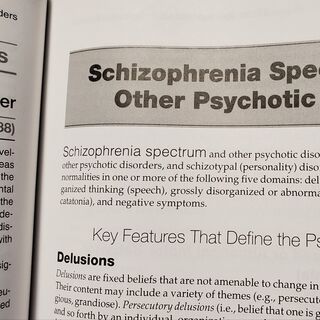Suicide
A Brief History of Clozapine
Despite controversy, clozapine remains the most effective antipsychotic drug.
Posted March 21, 2022 Reviewed by Jessica Schrader
Key points
- Clozapine was synthesized in 1958 but not FDA-approved in the U.S. until 1989.
- A series of deaths from agranulocytosis in Finland halted research on clozapine for nearly a decade.
- With blood monitoring and careful prescribing, clozapine is safe and highly effective.
Clozapine is the most effective antipsychotic medication (Siskind, McCartney, Goldschlager, & Kisely, 2016; McEvoy et al., 2006) and the only antipsychotic that has been shown to decrease suicide and the overall mortality for individuals with schizophrenia (Meltzer et al., 2003). Yet, it is prescribed much less frequently in the United States than in many other countries around the world (Meltzer, 2012). Clozapine's history, which I will briefly review here, has been a fascinating and contentious one.
Early Development
The 1950s marked the start of a psychopharmacological revolution in psychiatry with the discovery of the first effective antipsychotic and antidepressant medications. Chlorpromazine, the first antipsychotic, was discovered serendipitously by a French military surgeon in Tunisia named Henri Laborit, who was looking for a way to reduce post-surgical shock. Impressed by the notable psychological effects of the drug, he wrote in 1952, "These findings allow one to anticipate certain indications for the use of this compound in psychiatry."
Soon after chlorpromazine's introduction as an antipsychotic (or neuroleptic), other pharmaceutical companies sought to find similar compounds to compete with chlorpromazine on the new antipsychotic market. One such drug, imipramine, showed no effect on schizophrenia but proved to be effective in the treatment of depression. Imipramine was released in 1958 as the first tricyclic antidepressant.

In 1958, a Swiss pharmaceutical company, Wander AG, synthesized some tricyclic compounds similar to imipramine and in 1960 submitted a patent to examine one of them, clozapine. In animal studies, clozapine seemed to act more like chlorpromazine than imipramine, so it was decided to try the drug in patients with schizophrenia. By 1966, more than 100 patients had received clozapine and results were promising with regard to its antipsychotic efficacy (Crilly, 2007). Sandoz acquired Wander AG and in 1970 applied for and subsequently received a U.S. patent for clozapine.
The Finnish Epidemic and Agranulocytosis
In 1975, testing of clozapine was put on hold when "a cluster of elderly and infirm patients in Finland developed agranulocytosis [a serious condition characterized by extremely low white blood cell count], leading to eight deaths…. The ensuing investigation rejected the conclusion that clozapine was the cause of these deaths, at least through an agranulocytosis mechanism. Nevertheless, these deaths led to its withdrawal from general use" (Meltzer, 2012).
Why clozapine causes agranulocytosis in some but not most patients is still unknown. The risk is generally small, occurring in less than eight persons per 1,000 (Opler, 2017). "We also know that with monitoring of white blood cell (WBC) counts, neutropenia (low granulocyte count) can be identified so that clozapine can be stopped, thereby preventing progression to agranulocytosis. We also have an antidote, granulocyte colony stimulating factor or filgrastim, which when administered subcutaneously rapidly leads to the production of granulocytes" (Opler, 2017).
So, the risk of death from clozapine is small, while the risk of suicide among persons with schizophrenia is 20% (Meltzer, 2012). There is also evidence that clozapine is associated with lower mortality from causes other than suicide (Hayes et al., 2015).
FDA Approval and Launch in the U.S.
In 1984, the FDA permitted Sandoz to resume clinical trials of clozapine. However, instead of requiring clozapine to outperform placebo, Sandoz and the FDA agreed that the bar would have to be set even higher: Clozapine would need to demonstrate efficacy in patients who had failed to improve on adequate trials of three or more antipsychotics from at least two different classes. Opler (2017) provides an excellent summary of the FDA approval process for clozapine.
In 1989, clozapine was approved by the FDA for either intolerable motor side effects or refractory schizophrenia, meaning patients had to have failed at least two adequate trials of two different antipsychotics before they were eligible to receive clozapine. In December 2002, the FDA also approved clozapine for suicidality.
Following the FDA's approval of clozapine in 1989, some states began to cover clozapine under their Medicaid plans. Others, like New York, initially refused to do so due to costs associated with treatment. Still today, there remain discrepancies in clozapine utilization between states resulting from insurance-related factors (see Torrey, 2016).
Current Status
There is a general consensus in academic American psychiatry that clozapine is underprescribed in favor of other antipsychotic agents in the treatment of schizophrenia. Opler (2017) notes that of all atypical antipsychotics marketed since clozapine, none are as effective as it. Torrey (2016) asks, "Since clozapine is administratively more expensive to use initially [due to blood monitoring requirements] but has been proven to save money in the long run by decreasing re-hospitalization rates, are the for-profit managed care companies only interested in short-term profits?"
Rates of clozapine use vary worldwide with reports of 20% to 30% in China (Xiang et al., 2011) and 19% in Australia (Malalgama et al., 2011), but less than 5% in the U.S. (Meltzer, 2012).
Conclusion
Clozapine's history has been marked by its long path to FDA approval and underutilization in the U.S. since that time. It remains the most effective agent in the treatment of schizophrenia, and the risk of serious complications from agranulocytosis is very low with blood monitoring. Not only does clozapine improve the quality of life in schizophrenia patients, it also saves lives by lowering the risk of suicide and mortality from other causes.
References
Crilly, J. (2007). The history of clozapine and its emergence in the U.S. market: A review and analysis. History of Psychiatry, 18, 39-60.
Torrey, E. F. (2016). Why clozapine use varies by state. Psychiatric Times. https://www.psychiatrictimes.com/view/why-clozapine-use-varies-state
Hayes, R. D., Downs, J., Chang, C. K., Jackson, R. G., Shetty, H., Broadbent, M., Hotopf, M., & Stewart, R. (2015). The effect of clozapine on premature mortality: An assessment of clinical monitoring and other potential confounders. Schizophrenia Bulletin, 41(3), 644–655. https://doi.org/10.1093/schbul/sbu120
Laborit, H., Huguenard, P., & Alluame, R. (1952). Un nouveau stabilisateur végétatif; Le 4560 RP [A new vegetative stabilizer; 4560 R.P..]. La Presse medicale, 60(10), 206–208.
Malalagama, G., Bastiampillai, T., & Dhillon, R. (2011). Clozapine use in Australia. Australasian Psychiatry: Bulletin of Royal Australian and New Zealand College of Psychiatrists, 19(2), 175. https://doi.org/10.3109/10398562.2010.525646
McEvoy, J. P., Lieberman, J. A., Stroup, T. S., Davis, S. M., Meltzer, H. Y., Rosenheck, R. A., Swartz, M. S., Perkins, D. O., Keefe, R. S., Davis, C. E., Severe, J., Hsiao, J. K., & CATIE Investigators (2006). Effectiveness of clozapine versus olanzapine, quetiapine, and risperidone in patients with chronic schizophrenia who did not respond to prior atypical antipsychotic treatment. The American Journal of Psychiatry, 163(4), 600–610. https://doi.org/10.1176/appi.ajp.163.4.600
Meltzer H. Y. (2012). Clozapine: Balancing safety with superior antipsychotic efficacy. Clinical Schizophrenia & Related Psychoses, 6(3), 134–144. https://doi.org/10.3371/CSRP.6.3.5
Opler, L. (2017). [Chapters on clozapine]. In L. Opler, R. S. Laitman, A. M. Laitman, & D. Laitman. Meaningful recovery from schizophrenia and serious mental illness with clozapine. Published by authors.
Siskind, D., McCartney, L., Goldschlager, R., & Kisely, S. (2016). Clozapine v. first- and second-generation antipsychotics in treatment-refractory schizophrenia: Systematic review and meta-analysis. The British Journal of Psychiatry: The Journal of Mental Science, 209(5), 385–392. https://doi.org/10.1192/bjp.bp.115.177261
Xiang, Y. T., Wang, C. Y., Si, T. M., Lee, E. H., He, Y. L., Ungvari, G. S., Chiu, H. F., Shinfuku, N., Yang, S. Y., Chong, M. Y., Kua, E. H., Fujii, S., Sim, K., Yong, M. K., Trivedi, J. K., Chung, E. K., Udomratn, P., Chee, K. Y., Sartorius, N., Dixon, L. B., … Tan, C. H. (2011). Clozapine use in schizophrenia: Findings of the Research on Asia Psychotropic Prescription (REAP) studies from 2001 to 2009. The Australian and New Zealand Journal of Psychiatry, 45(11), 968–975. https://doi.org/10.3109/00048674.2011.607426




